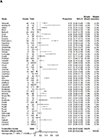Epidemiology and outcomes of clinically unsuspected venous thromboembolism in children: A systematic review
- PMID: 31984669
- PMCID: PMC7192773
- DOI: 10.1111/jth.14739
Epidemiology and outcomes of clinically unsuspected venous thromboembolism in children: A systematic review
Abstract
Background: Clinically unsuspected venous thromboembolic events (uVTE) detected during routine imaging pose a management challenge due to limited knowledge about their clinical significance. Unsuspected VTE are often referred as "asymptomatic," "incidental," or "clinically silent/occult" VTE.
Objective: To understand the epidemiology, management, and outcomes of uVTE in children.
Methods: A systematic review was performed according to PRISMA (Preferred Reporting Items for Systematic Reviews and Meta-Analyses) guidelines. The search criteria included controlled vocabulary and keywords for VTE, incidental findings, and children (ages ≤ 21 years).
Results: Among 10 875 articles, 51 studies (8354 children with 758 uVTE) were selected. The studies were heterogeneous, I2 96%; P < .0001. Unsuspected VTE were diagnosed in two settings: first, asymptomatic VTE (aVTE) diagnosed through surveillance imaging for VTE (46 studies; n = 5894; aVTE: 715, pooled frequency: 19%, 95% confidence interval [CI]: 13%-24%); second, incidental VTE (iVTE) diagnosed during imaging performed for indications without primary suspicion for VTE (6 studies; n = 2460; iVTE: 43). The majority (94%) of aVTE were associated with central venous lines (CVL). Non-CVL settings included post-spinal surgery, post-splenectomy, trauma, nephrotic syndrome, and newborns. In general, aVTE were reported to have a benign clinical course, were mostly transient, and resolved without intervention and with few immediate or long-term functional complications. Incidental VTE were primarily detected in children with cancer and ranged from tumor-associated thrombi to pulmonary embolism (PE) with insufficient evidence to draw meaningful conclusions about their management.
Conclusion: Clinically uVTE were predominantly diagnosed with CVL and their outcomes were generally favorable implying limited benefit of routine surveillance and thromboprophylaxis. Prospective research is needed to clarify the optimal management of iVTE.
Keywords: asymptomatic venous thromboembolism; central venous line; incidental venous thromboembolism; pediatric; unsuspected venous thromboembolism; venous thromboembolism.
© 2020 International Society on Thrombosis and Haemostasis.
Conflict of interest statement
Conflicts of interest
Authors declare report no potential conflicts of interest.
Figures



References
-
- Andrew M, Marzinotto V, Pencharz P, Zlotkin S, Burrows P, Ingram J, Adams M, Filler R. A cross-sectional study of catheter-related thrombosis in children receiving total parenteral nutrition at home. The Journal of pediatrics. 1995; 126: 358–63. - PubMed
-
- Beck C, Dubois J, Grignon A, Lacroix J, David M. Incidence and risk factors of catheter-related deep vein thrombosis in a pediatric intensive care unit: a prospective study. The Journal of pediatrics. 1998; 133: 237–41. - PubMed
-
- Faustino EV, Spinella PC, Li S, Pinto MG, Stoltz P, Tala J, Card ME, Northrup V, Baker KE, Goodman TR, Chen L, Silva CT. Incidence and acute complications of asymptomatic central venous catheter-related deep venous thrombosis in critically ill children. The Journal of pediatrics. 2013; 162: 387–91. 10.1016/j.jpeds.2012.06.059. - DOI - PMC - PubMed
-
- Jones S, Newall F, Butt W, Monagle P. Asymptomatic thrombosis following the use of central venous lines in children. University of Melbourne Minerva Access. 2017: 26–264. 10.1182/blood-2018-05-849737. - DOI
-
- Journeycake JM, Quinn CT, Miller KL, Zajac JL, Buchanan GR. Catheter-related deep venous thrombosis in children with hemophilia. Blood. 2001; 98: 1727–31. - PubMed
Publication types
MeSH terms
Substances
Grants and funding
LinkOut - more resources
Full Text Sources
Medical

